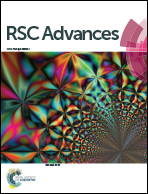Reinforcement of phenylalanine-based supramolecular hydrogels by hybridizing poly(N-isopropylacrylamide) nanogels
Abstract
In an aqueous solution of an L-phenylalanine derivative-based gelator, the addition of a suitable amount of thermosensitive poly(N-isopropylacrylamide) nanogel particles leads to the formation of hybridized supramolecular hydrogels. Due to the presence of the nanogel particles, the gelation ability of the gelator can be improved as shown by the decrease of the critical gelation concentration (CGC) of the gelator from 2.5 wt% to 0.8 wt% when 1 wt% of nanogels was employed. Meanwhile, the thermostability of the hybridized system was also improved. For instance, the phase transition temperature (TGS) increased from 48 °C to 61 °C. Rheological studies indicated that the supramolecular hydrogels can be significantly reinforced by hybridizing 0.6 wt% nanogels. When used as a drug carrier, the drug release behavior from the hybridized system can be controlled by changing the content of nanogels as well as the temperature.


 Please wait while we load your content...
Please wait while we load your content...